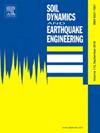Reproducing nonlinear ground response and pore pressure variations using in-situ soil properties
IF 4.2
2区 工程技术
Q1 ENGINEERING, GEOLOGICAL
引用次数: 0
Abstract
In this study, we proposed a novel method to extract pore pressure model parameters from vertical array seismic records and pore water pressure data, building upon the existing method for estimating in-situ soil dynamic parameters. Using the extracted in-situ soil properties, one-dimensional effective stress analysis is conducted in DEEPSOIL to reproduce and predict the nonlinear ground response and pore pressure variations at the Wildlife Liquefaction Array, California. Our results show that: (1) the increase and dissipation process of excess pore water pressure can be well empirically modeled using the Hill Equation and an exponential decay function, respectively; (2) the simulated ground response and pore pressure variations using in-situ soil properties are consistent with the observations, which demonstrates the feasibility and effectiveness of using in-situ soil properties to predict pore pressure variations during strong motions; (3) effective stress analysis does not outperform total stress analysis in ground response analysis when the excess pore water pressure ratio (ru) is no greater than 0.6, but can be used to evaluate the potential for liquefaction triggering; (4) when simulated ru > 0.9, there are clear differences between the simulated ground motions using total stress and effective stress analyses at this site.
利用原位土壤特性再现非线性地基响应和孔隙压力变化
本研究在现有原位土体动力参数估算方法的基础上,提出了一种从垂向地震记录和孔隙水压力数据中提取孔隙压力模型参数的新方法。利用提取的原位土壤特性,在DEEPSOIL中进行一维有效应力分析,以再现和预测加州野生动物液化阵列的非线性地面响应和孔隙压力变化。研究结果表明:(1)利用Hill方程和指数衰减函数可以很好地模拟超孔隙水压力的增加和消散过程;(2)利用原位土性模拟的地基响应和孔隙压力变化与观测值吻合较好,证明了利用原位土性预测强运动过程中孔隙压力变化的可行性和有效性;(3)当超孔隙水压力比(ru)不大于0.6时,有效应力分析在地响应分析中并不优于总应力分析,但可用于评价液化触发潜力;(4)模拟运行时;0.9,用总应力和有效应力分析模拟的地震动有明显的差异。
本文章由计算机程序翻译,如有差异,请以英文原文为准。
求助全文
约1分钟内获得全文
求助全文
来源期刊

Soil Dynamics and Earthquake Engineering
工程技术-地球科学综合
CiteScore
7.50
自引率
15.00%
发文量
446
审稿时长
8 months
期刊介绍:
The journal aims to encourage and enhance the role of mechanics and other disciplines as they relate to earthquake engineering by providing opportunities for the publication of the work of applied mathematicians, engineers and other applied scientists involved in solving problems closely related to the field of earthquake engineering and geotechnical earthquake engineering.
Emphasis is placed on new concepts and techniques, but case histories will also be published if they enhance the presentation and understanding of new technical concepts.
 求助内容:
求助内容: 应助结果提醒方式:
应助结果提醒方式:


